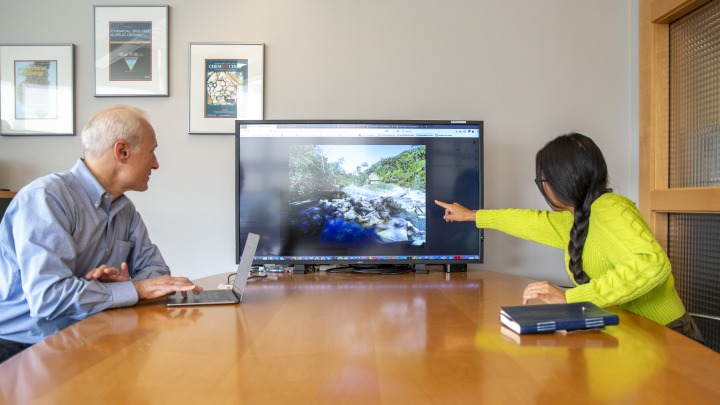
Seeking bacterial survival mechanisms in the ‘MicroAmazon’

Deep in the Peruvian Amazon, large mats of cyanobacteria are afloat, surviving, thriving, atop a river so hot that it boils.
This August, researchers will travel more than 3,500 miles from the University of Michigan Life Sciences Institute to the Mayantuyacu Community in Peru in search of the organisms that can proliferate in such an extreme environment.
“We want to uncover the mechanisms these bacteria use to survive in such high temperatures and determine how we might be able to engineer or hack those processes in the lab,” says Rosa Vasquez Espinoza, a graduate student studying in the lab of LSI faculty member David Sherman, Ph.D. “Could this potentially lead to novel natural products? We want to find out — because right now, no one really even knows what we have in there.”
The Peruvian Boiling River is unique among thermal rivers, or rivers that receive heat from within the Earth. Every other identified geothermal river receives its heat from a nearby volcano. The closest volcano to the Boiling River, however, is more than 430 miles away, making this the only known hot river that does not have volcanic origins. Researchers are still trying to determine how such a large, fast-moving river is able to reach 99.1 degrees Celsius, with average temperatures exceeding 80 degrees Celsius.
Vasquez will lead a team with Sherman and their colleagues from Peru’s National Agrarian University – La Molina and the Boiling River Project in exploring the river’s ecosystem to learn more about the species living there — some of which exist only in this small stretch of the Amazon rainforest. This project, “MicroAmazon: The Hidden World of Amazonian Extremophiles,” was named a National Geographic Early Career Grant recipient in 2019.
“At a high level, we want to understand what is in their genomes and how their enzymes compare to those of other organisms that can’t exist at these temperatures,” says Sherman, who is also a professor of medicinal chemistry in the U-M College of Pharmacy and a professor of microbiology and immunology in the U-M Medical School. “And then we want to determine if they have unique abilities to make metabolites that protect them – and whether that could offer new avenues to developing antibiotics, antifungal agents or antivirals.”
In addition to natural products discovery, the team’s wide ranging research will also touch on microbiology, geoscience, conservation and sustainability efforts.
The National Geographic Early Career Grant program supports less experienced individuals to lead a “bold, innovative, and potentially transformative” project focused in conservation, education, research, storytelling or technology. In addition to providing a monetary funding that supports the research, the program connects members to a broader network of Explorers and provides researchers with the skills and channels to communicate widely about their work.


